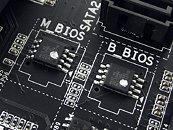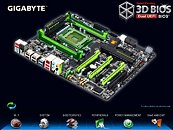Monday, June 18th 2018

AMD Motherboard Vendors Are Removing Support for Older CPU Models
Current AMD AM4 motherboards basically support four platforms at the moment: the new Ryzen 2000 processors, Ryzen 2000 G APUs with integrated graphics, 1st generation Ryzen and Bristol Ridge. Bristol Ridge was AMD's last processor generation before Ryzen was released. Bristol Ridge introduced Socket AM4, which according to AMD has a lifespan beyond 2020. According to Anandtech, several motherboard manufacturers are now reporting that they might drop support for Bristol Ridge in their future motherboard releases. The underlying reason is that in addition to the setup interface, and UEFI with its driver and network stack, the BIOS has to support all processors by including microcode for them.
Supporting so many CPU models bloats the size of the BIOS beyond 128 megabits (16 MB), which would exceed the capacity of the BIOS flash chips used by most vendors and force them to use higher capacity models, ie 256 megabits. As always in this industry, the issue here comes down to pricing.A 128 Mb flash chip costs less than half as much as a 256 Mb chip - a cost that motherboard vendors seem reluctant to cover, especially considering the limited commercial success of Bristol Ridge. We're talking about $3-4 price differences here, which sounds like nothing at first, but will add up with millions of motherboards shipped. Also these few dollars could make you lose a price advantage over a competitor.
There is no question that the vast majority of processors used on AM4 motherboards will be Ryzen; the only mention of Bristol Ridge that I've seen in recent times is, ironically, that the processor that AMD ships to users to upgrade their BIOS for Ryzen support is Bristol Ridge, as that's the cheapest way to get an AM4 system up and running. So the reality is that Bristol Ridge support will be irrelevant for 99% of future AM4 motherboards.
Instead of dropping Bristol support, motherboard vendors could release special BIOS versions that support only Bristol Ridge, but not Ryzen, and vice versa. This seems highly unlikely as it would significantly increase complexity for qualification and maintenance of the BIOS and the chances of people flashing the wrong BIOS version would be high, too. Maybe we could see a reduction in the BIOS fanciness that we saw with the introduction of UEFI. Do we really need all the bells and whistles that modern UEFI-style BIOSes offer? Last but not least, two BIOS chips could be used in a RAID-0-like striping configuration, combining their capacity. Such an approach probably wouldn't be much cheaper and the added design complexity and PCB space usage would offset all cost savings.
Source:
Anandtech
Supporting so many CPU models bloats the size of the BIOS beyond 128 megabits (16 MB), which would exceed the capacity of the BIOS flash chips used by most vendors and force them to use higher capacity models, ie 256 megabits. As always in this industry, the issue here comes down to pricing.A 128 Mb flash chip costs less than half as much as a 256 Mb chip - a cost that motherboard vendors seem reluctant to cover, especially considering the limited commercial success of Bristol Ridge. We're talking about $3-4 price differences here, which sounds like nothing at first, but will add up with millions of motherboards shipped. Also these few dollars could make you lose a price advantage over a competitor.
There is no question that the vast majority of processors used on AM4 motherboards will be Ryzen; the only mention of Bristol Ridge that I've seen in recent times is, ironically, that the processor that AMD ships to users to upgrade their BIOS for Ryzen support is Bristol Ridge, as that's the cheapest way to get an AM4 system up and running. So the reality is that Bristol Ridge support will be irrelevant for 99% of future AM4 motherboards.
Instead of dropping Bristol support, motherboard vendors could release special BIOS versions that support only Bristol Ridge, but not Ryzen, and vice versa. This seems highly unlikely as it would significantly increase complexity for qualification and maintenance of the BIOS and the chances of people flashing the wrong BIOS version would be high, too. Maybe we could see a reduction in the BIOS fanciness that we saw with the introduction of UEFI. Do we really need all the bells and whistles that modern UEFI-style BIOSes offer? Last but not least, two BIOS chips could be used in a RAID-0-like striping configuration, combining their capacity. Such an approach probably wouldn't be much cheaper and the added design complexity and PCB space usage would offset all cost savings.


30 Comments on AMD Motherboard Vendors Are Removing Support for Older CPU Models
AMD has never committed for those and as long as Ryzen gen 1 remains upgrade-able to gens 2-4 we're golden.
Do what you have in order to supply better support for relevant hardware
Well yea, that is probably true although it also cost less than half as much as a 1Tb chip :)
edit: I know it's a typo btw
On the other hand, instead of so much fancy crap, we could do just fine with a classic interface. It's not like we work all day in UEFI
When intel launches a new chipset for a single generation, everyone talks about how horrible it is, and how intel needs to support their hardware better, but then AMD drops support for a CPU generation and suddenly everything is hunky dory?
After all, if current motherboards cant support both raven ridge and bristol ridge along with zen, what happens in a year when raven ridge + and zen 2 come out, and zen 1 and raven ridge are dropped for the same reason? Are people going to go on about how removing CPU support is a good thing now?The "promise" here is AMD supporting their platform, removing CPU support fragments a platform, which people give intel an endless amount of shit for. It's only fair that AMD will get slagged for it as well.
On a more humorous note, AMD has underdog status, which reduces the amount of crap they will get for this by 75%...
So basically AMD want to have long term motherboard upgradability to differentiate with Intel but motherboard makers don't want to loose a chance to sell more motherboards and will use this trick to self limits it's motherboards?
FX worked ok in desktop market, mobile not so much.
Stop trying to spread FUD! :slap: @nienorgt:roll::roll:
Difference is intel changes sockets every other yearNope All Ryzen
As for AMD's underdog status, see below:Apparently dropping CPU support is fine because they were not efficient enough. I cant wait for the excuses when zen is dropped for zen 2 support, and how this is totally better then intel requiring new motherboards every 2 years.
Fyi Ryzen had bigger success than Bristolridge so your point is moot.
The success of Ryzen does not make the point moot. Ask yourself this genius: if motherboards cannot hold microcode for Bristol, raven, and zen at the same time due to space limitations, what is going to happen next year, when you have raven ridge 2 and zen 2 on the market, and some AM4 motherboard will support both, some will only support gen 1, and some will only support gen 2 because of limitations, and people have to buy new AM4 motherboards because they cant run zen 2 on their older AM4 board?
The point wont be so moot when your platform is fragmented beyond recognition, and your promise of support until 2020 becomes a nightmare of incompatibilities straight out of 1995. :slap:
Everything's gotta be bloated well beyond the brim these days... kinda ridiculous.
This is actually worse than the clickbait-titles everyone hates - sure, they don't tell anything about the subject, but at least they're not straight up lying about the subject either.
Bulldozer was a port of the 45nm version, barebone 32nm port.
Piledriver included the Jaguar branch predictor, used the overhauled 32nm transistor, included Cyclos' Resonant Clock Mesh, included fixes in FPU/Decode/etc, had a larger L1 DTLB, Load Queue, and more.
Steamroller came in with two versions one for servers and one for mobile. The server version was dropped and the mobile version was used throughout(Steamroller onward). Mobile version did;
- Lower average and peak power; micro-architecture/L2 cache optimizations
- Redesigned the FPU to be more efficient
- Switched from a shared Decode to a private per-core Decode. There was also an overhaul in the prefetch/fetch area.
- Utilized the AMD's branch version of Resonant Clock Mesh. (AMD/rcm rather than Cyclos/rcm which was more safe power-wise.)
Excavator also came in with two versions one for 20nm LPM and 28nm A(an overhaul of 28SHP for more area.). The 20LPM version was dropped. Excavator brought 15h to the power-optimized roadmap at GloFo. The changes that Carrizo/Excavator(28A) and Bristol Ridge/Excavator+(28HPA) are pretty big.
- AVFS/IVR in some Carrizo models, AVFS/IVR in all Bristol Ridge models.
- Large L1ds and a smaller L2 cache.
- Most of Carrizo/Bristol Ridge is in the SoC area; HSA1.0 Spec Compliant, DDR4 Support, Carrizo with GCN3+(Fiji/Pirate Islands) and Bristol Ridge with GCN4(Polaris/Arctic Islands).
- Bristol Ridge brought all of Carrizo's mobile optimizations to the desktop parts; A12-9800/etc.
Excavator with Bristol Ridge(+Stoney Ridge) is thus the most efficient 15h architecture/SoC. There is a lot of stuff they did with Bulldozer through Excavator which I might not have covered.
Fiji and Polaris both utilize the "GCN2" ISA;
gfx801 = Carrizo
gfx803 = Fiji, Polaris
gfx810 = Stoney, Bristol
gfx900 = Vega
gfx902 = RavenBristol Ridge and Stoney Ridge utilize IP after Fiji/Polaris; GFX810, rather than GFX803.
Trust me, Stoney/Bristol is GCN4 with Polaris RX580-RX550. (Which by the way uses GFX810 as well... the confusion increases!)
Developers for AMD software are more correct than AMD marketing, imho.